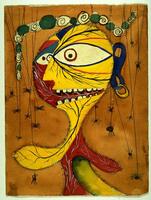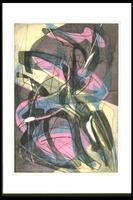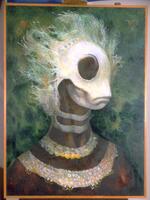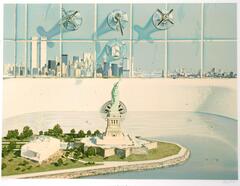16 Items in this Learning Collection
Resource with 15 media
Collection Object
Collection Object
Collection Object
Collection Object
Collection Object
Collection Object
Collection Object
Collection Object
Collection Object
Collection Object
Collection Object
Collection Object
Collection Object
Copyright
All Rights Reserved
()
I Want To See It To Believe It
Accession Number
1947/2.13
Title
I Want To See It To Believe It
Artist(s)
Roberto Matta
Artist Nationality
Chilean
Object Creation Date
1947
Medium & Support
color lithograph on paper
Dimensions
16 1/2 in x 13 in (41.91 cm x 33.02 cm);16 1/2 in x 13 in (41.91 cm x 33.02 cm);22 1/16 in x 18 1/8 in (56.04 cm x 46.04 cm);28 1/8 in x 22 1/8 in (71.44 cm x 56.2 cm)
Credit Line
Museum Purchase
Label copy
At the request of art critic Nicholas Calas, seven Surrealist artists collaborated on a print portfolio published by Brunidor Editions, in New York, whose director was Robert Altmann. The artists were Max Ernst, Stanley William Hayter, Wifredo Lam, Matta, Joan Miró, Kurt Seligmann, and Yves Tanguy. The etchings were printed in Hayter’s Atelier 17, while the lithographs were pulled in the studio of Alfred Jones.
Calas’ introduction to the portfolio turned on the age-old controversy between line and color, in which line or form is seen as relating to thought, while color or light is considered pertinent to emotion. Excerpts from his essay, entitled "Saper Vedere" (To Know How to See), are given in italics in the labels accompanying each of the prints from the portfolio, all of which are exhibited here. Calas describes not only what these artists "see" with their imaginations, but also what he as a critic "sees" as he interprets the inherent meanings of these prints.
University of Michigan Museum of Art director Jean Paul Slusser in 1947 showed himself to be in the vanguard of contemporary trends in his recommendation that this portfolio be acquired in the very year it was published.
. . . the humor in Matta’s cartoon is of the cruellest kind, based as it is on the realization of the incongruity of a situation which is tragic rather than comic. It is the story-portrait of the narcissist wounded in his pride, of the dandy admiring his wound; it is the drama of isolation portrayed on a cross, now situated in the stratosphere.
Matta studied architecture in his native Chile, moving in 1933 to Paris, where he was a draftsman in the studio of the architect Le Corbusier. In the mid-1930s he went to Madrid, where met Dalí and Breton. His earliest Surrealist works evince his interest in automatism, a procedure that he later shared with artists such as Gerome Kamrowski and Jackson Pollock after he immigrated to the United States in 1939. In 1944 Duchamp influenced his turn from biomorphism to geometry. In reaction to World War II, images of machines, automata, and the deformed human body entered his work.
Matta’s lithograph in The Brunidor Portfolio is also known as Strange Situation (Open Cube [cube ouvert]).
Label copy from exhibition "Dreamscapes: The Surrealist Impulse," August 22 - October 25, 1998
Subject matter
This print is part of a portfolio published by Brunidor Editions, New York (the portfolio's namesake), at the request of art critic Nicholas Calas, and included six prints from a number of prominent Surrealist artists, including: Max Ernst, Stanley William Hayter, Wifredo Lam, Joan Miró, Kurt Seligmann, and Yves Tanguy. Calas’ introduction to the portfolio turned on the age-old controversy between line and color, in which line or form is seen as relating to thought, while color or light is considered pertinent to emotion. Excerpts from his essay, entitled "Saper Vedere" (To Know How to See), are given in italics in the labels accompanying each of the prints from the portfolio, all of which are exhibited here. Calas describes not only what these artists "see" with their imaginations, but also what he as a critic "sees" as he interprets the inherent meanings of these prints.
Matta's contribution, plate five of six, reflects his previous study of architecture in the regular grid and detailed line drawing. At the same time, it represents his engagement with Surrealism. After meeting painter Salvador Dali and poet André Breton in Paris, Matta joined the Surrealist movement before the war. Matta's work engaged in Freud's ideas of the subconscious mind; and like other Surrealists, he used an automatic artistic process to create his work, unmuddied by premeditation. The Chilean artist was well aware of the political climate in the immediate aftermath of the Second World War and became involved in political activism. The humanoid figures are transected by planes and integrated with mechanical-looking parts, pointing to the new atomic age of man.
Physical Description
This vertical print is bisected by four horizontal light blue squares approximately one third of the way up from the bottom. The second square from the left is joined by a square above and below so that all the liight blue squares create a horizontally oriented cross. Both inside and outside the cross-grid there are seven tan figures, who seem to be engaged in a variety of activities. There are a number of designs that move out from the cross, some related to what is pictured inside and some not. The print is signed and dated (l.l.) "Matta 47" and numbered (l.r.) "57/70" in pencil.
Primary Object Classification
Print
Collection Area
Modern and Contemporary
Rights
If you are interested in using an image for a publication, please visit http://umma.umich.edu/request-image for more information and to fill out the online Image Rights and Reproductions Request Form.
Keywords
Latin American
Surrealism
Surrealist
architectural drawings (visual works)
automation
automaton
figures (representations)
modern and contemporary art
open cubes
portfolios (groups of works)
squares
1947/2.13
Title
I Want To See It To Believe It
Artist(s)
Roberto Matta
Artist Nationality
Chilean
Object Creation Date
1947
Medium & Support
color lithograph on paper
Dimensions
16 1/2 in x 13 in (41.91 cm x 33.02 cm);16 1/2 in x 13 in (41.91 cm x 33.02 cm);22 1/16 in x 18 1/8 in (56.04 cm x 46.04 cm);28 1/8 in x 22 1/8 in (71.44 cm x 56.2 cm)
Credit Line
Museum Purchase
Label copy
At the request of art critic Nicholas Calas, seven Surrealist artists collaborated on a print portfolio published by Brunidor Editions, in New York, whose director was Robert Altmann. The artists were Max Ernst, Stanley William Hayter, Wifredo Lam, Matta, Joan Miró, Kurt Seligmann, and Yves Tanguy. The etchings were printed in Hayter’s Atelier 17, while the lithographs were pulled in the studio of Alfred Jones.
Calas’ introduction to the portfolio turned on the age-old controversy between line and color, in which line or form is seen as relating to thought, while color or light is considered pertinent to emotion. Excerpts from his essay, entitled "Saper Vedere" (To Know How to See), are given in italics in the labels accompanying each of the prints from the portfolio, all of which are exhibited here. Calas describes not only what these artists "see" with their imaginations, but also what he as a critic "sees" as he interprets the inherent meanings of these prints.
University of Michigan Museum of Art director Jean Paul Slusser in 1947 showed himself to be in the vanguard of contemporary trends in his recommendation that this portfolio be acquired in the very year it was published.
. . . the humor in Matta’s cartoon is of the cruellest kind, based as it is on the realization of the incongruity of a situation which is tragic rather than comic. It is the story-portrait of the narcissist wounded in his pride, of the dandy admiring his wound; it is the drama of isolation portrayed on a cross, now situated in the stratosphere.
Matta studied architecture in his native Chile, moving in 1933 to Paris, where he was a draftsman in the studio of the architect Le Corbusier. In the mid-1930s he went to Madrid, where met Dalí and Breton. His earliest Surrealist works evince his interest in automatism, a procedure that he later shared with artists such as Gerome Kamrowski and Jackson Pollock after he immigrated to the United States in 1939. In 1944 Duchamp influenced his turn from biomorphism to geometry. In reaction to World War II, images of machines, automata, and the deformed human body entered his work.
Matta’s lithograph in The Brunidor Portfolio is also known as Strange Situation (Open Cube [cube ouvert]).
Label copy from exhibition "Dreamscapes: The Surrealist Impulse," August 22 - October 25, 1998
Subject matter
This print is part of a portfolio published by Brunidor Editions, New York (the portfolio's namesake), at the request of art critic Nicholas Calas, and included six prints from a number of prominent Surrealist artists, including: Max Ernst, Stanley William Hayter, Wifredo Lam, Joan Miró, Kurt Seligmann, and Yves Tanguy. Calas’ introduction to the portfolio turned on the age-old controversy between line and color, in which line or form is seen as relating to thought, while color or light is considered pertinent to emotion. Excerpts from his essay, entitled "Saper Vedere" (To Know How to See), are given in italics in the labels accompanying each of the prints from the portfolio, all of which are exhibited here. Calas describes not only what these artists "see" with their imaginations, but also what he as a critic "sees" as he interprets the inherent meanings of these prints.
Matta's contribution, plate five of six, reflects his previous study of architecture in the regular grid and detailed line drawing. At the same time, it represents his engagement with Surrealism. After meeting painter Salvador Dali and poet André Breton in Paris, Matta joined the Surrealist movement before the war. Matta's work engaged in Freud's ideas of the subconscious mind; and like other Surrealists, he used an automatic artistic process to create his work, unmuddied by premeditation. The Chilean artist was well aware of the political climate in the immediate aftermath of the Second World War and became involved in political activism. The humanoid figures are transected by planes and integrated with mechanical-looking parts, pointing to the new atomic age of man.
Physical Description
This vertical print is bisected by four horizontal light blue squares approximately one third of the way up from the bottom. The second square from the left is joined by a square above and below so that all the liight blue squares create a horizontally oriented cross. Both inside and outside the cross-grid there are seven tan figures, who seem to be engaged in a variety of activities. There are a number of designs that move out from the cross, some related to what is pictured inside and some not. The print is signed and dated (l.l.) "Matta 47" and numbered (l.r.) "57/70" in pencil.
Primary Object Classification
Collection Area
Modern and Contemporary
Rights
If you are interested in using an image for a publication, please visit http://umma.umich.edu/request-image for more information and to fill out the online Image Rights and Reproductions Request Form.
Keywords
Latin American
Surrealism
Surrealist
architectural drawings (visual works)
automation
automaton
figures (representations)
modern and contemporary art
open cubes
portfolios (groups of works)
squares
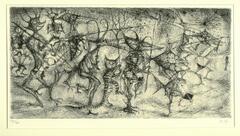

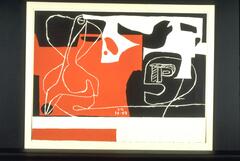
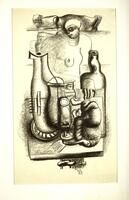
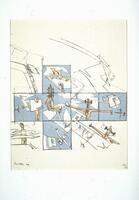
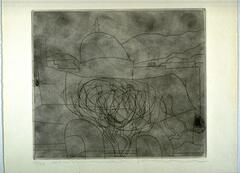
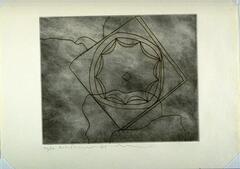
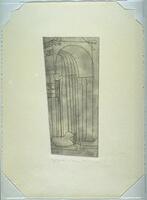

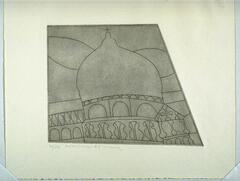

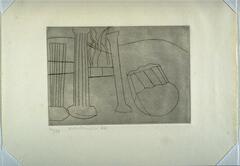
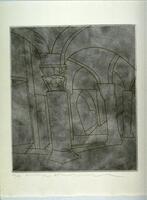
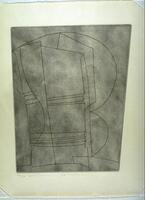
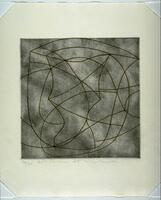
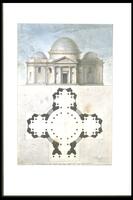
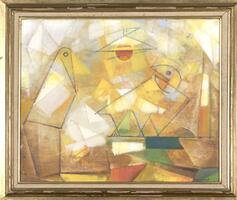
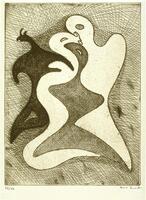
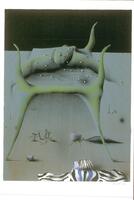
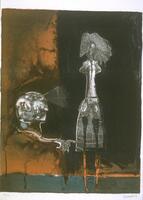

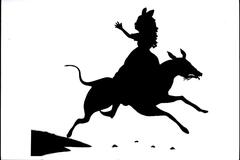

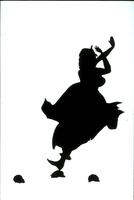

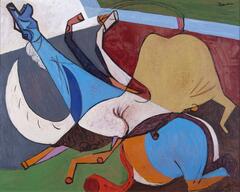
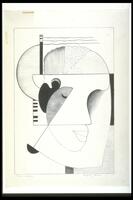
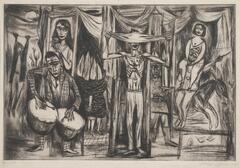

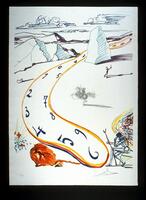
![In this mixed-media print, there is a white background with black outlines of facial features, lips and an eye, and a creature in the bottom left. In the upper left corner there is a rectanglular sheet in cream layered on top; a wavy vertical design stretches diagonally from the top of the rectangle to the bottom in yellow, red, and blue. Within this sheet, there are small figures at the center left drawn in black. To the right in the sheet, there is a collaged image of one of the artist's paintings, incorporated into a cube. Above, there are drawn birds. There is a small mechanical-like figure on the sheet at the bottom left. At the center of the print, in the cream page, the artist signed "Dali" and dated the print "1975. To the bottom left, on the larger white page, there is text inscribed in the plate, mirrored and someone illegible, that possibly reads "Leill Ciclopeer Alucire la bouche Almient tire / Lula [illegible]." The print is number at the lower left in pencil. In this mixed-media print, there is a white background with black outlines of facial features, lips and an eye, and a creature in the bottom left. In the upper left corner there is a rectanglular sheet in cream layered on top; a wavy vertical design stretches diagonally from the top of the rectangle to the bottom in yellow, red, and blue. Within this sheet, there are small figures at the center left drawn in black. To the right in the sheet, there is a collaged image of one of the artist's paintings, incorporated into a cube. Above, there are drawn birds. There is a small mechanical-like figure on the sheet at the bottom left. At the center of the print, in the cream page, the artist signed "Dali" and dated the print "1975. To the bottom left, on the larger white page, there is text inscribed in the plate, mirrored and someone illegible, that possibly reads "Leill Ciclopeer Alucire la bouche Almient tire / Lula [illegible]." The print is number at the lower left in pencil.](/media/W1siZiIsIjIwMjIvMDUvMjUvMWUwenVmM3Nlel9kZWZhdWx0LmpwZyJdLFsicCIsInRodW1iIiwiMjQweDIwMCJdXQ?sha=03c3865ec6fdec9d)
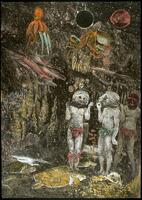
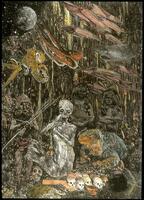
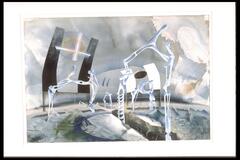
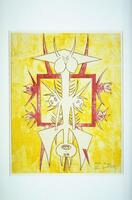

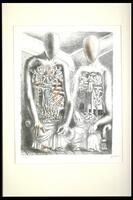

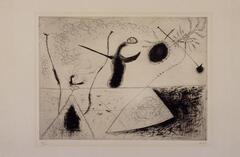
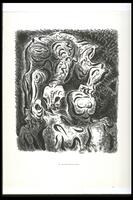
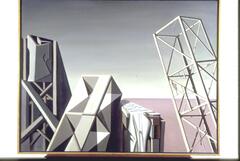

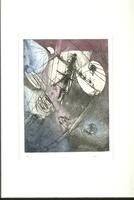


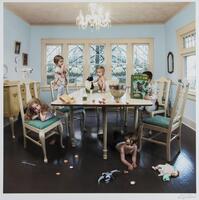
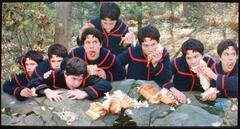
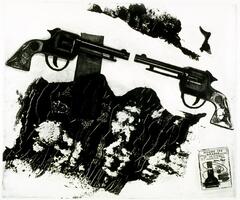
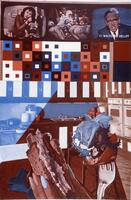
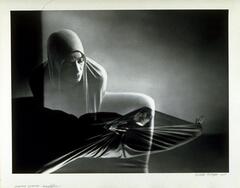
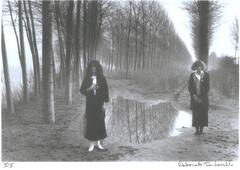

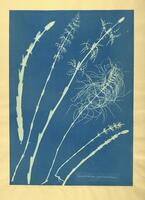
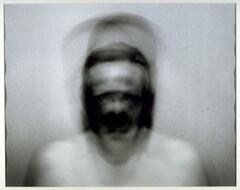
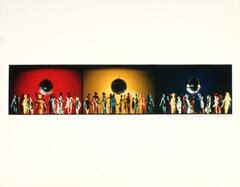


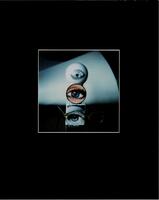

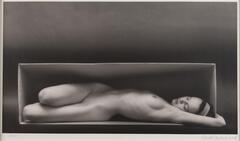
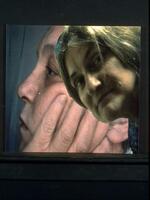
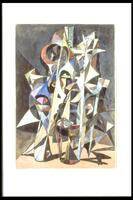
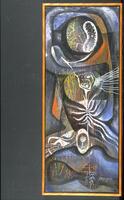
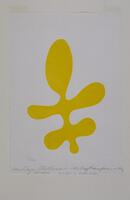

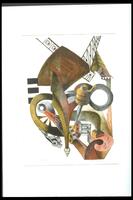
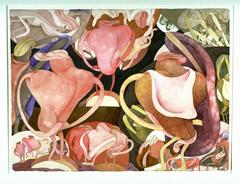
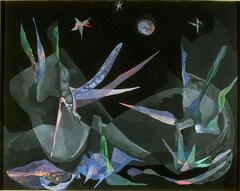

![A clear glass bubble rests on the bowl of a plain white clay pipe. Along the stem of the pipe are the words, "Ce que [sic] manque à nous tous." A clear glass bubble rests on the bowl of a plain white clay pipe. Along the stem of the pipe are the words, "Ce que [sic] manque à nous tous."](/media/W1siZiIsIjIwMjIvMDkvMjQvMmR5MHViN2o5Yl9kZWZhdWx0LmpwZyJdLFsicCIsInRodW1iIiwiMjQweDIwMCJdXQ?sha=e23a50659ff4d560)
